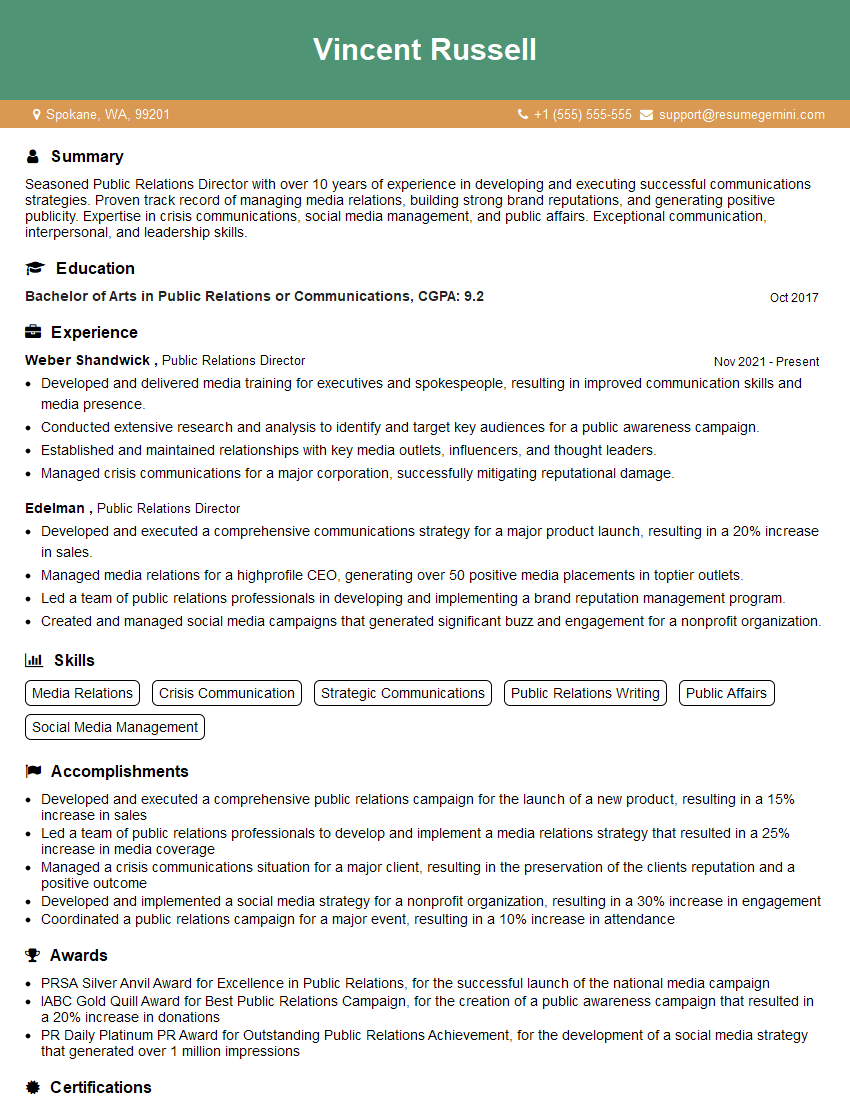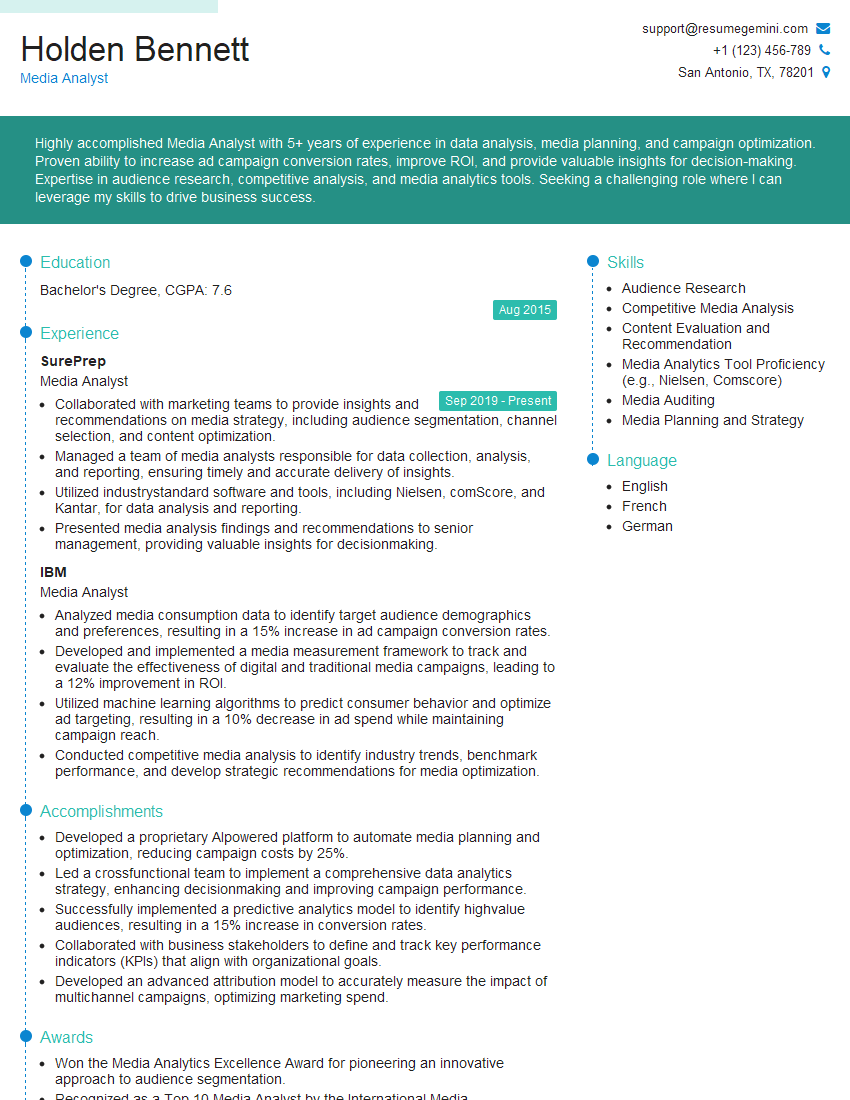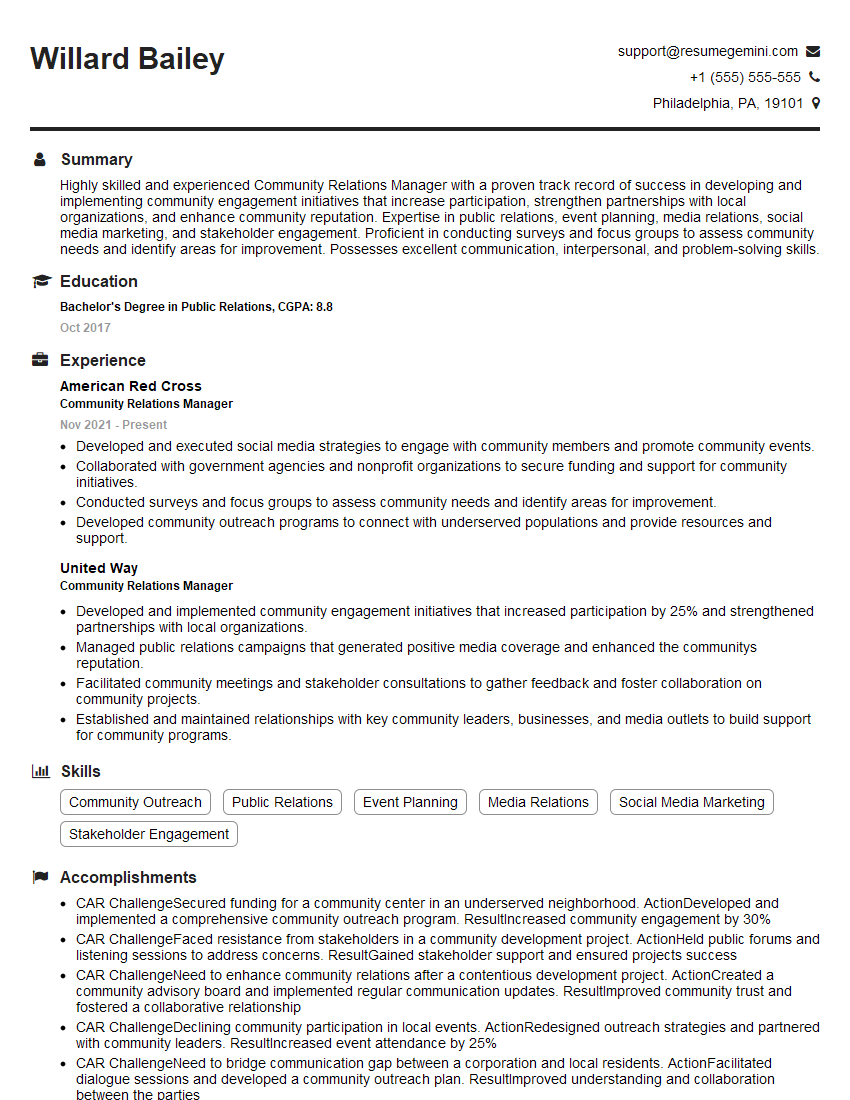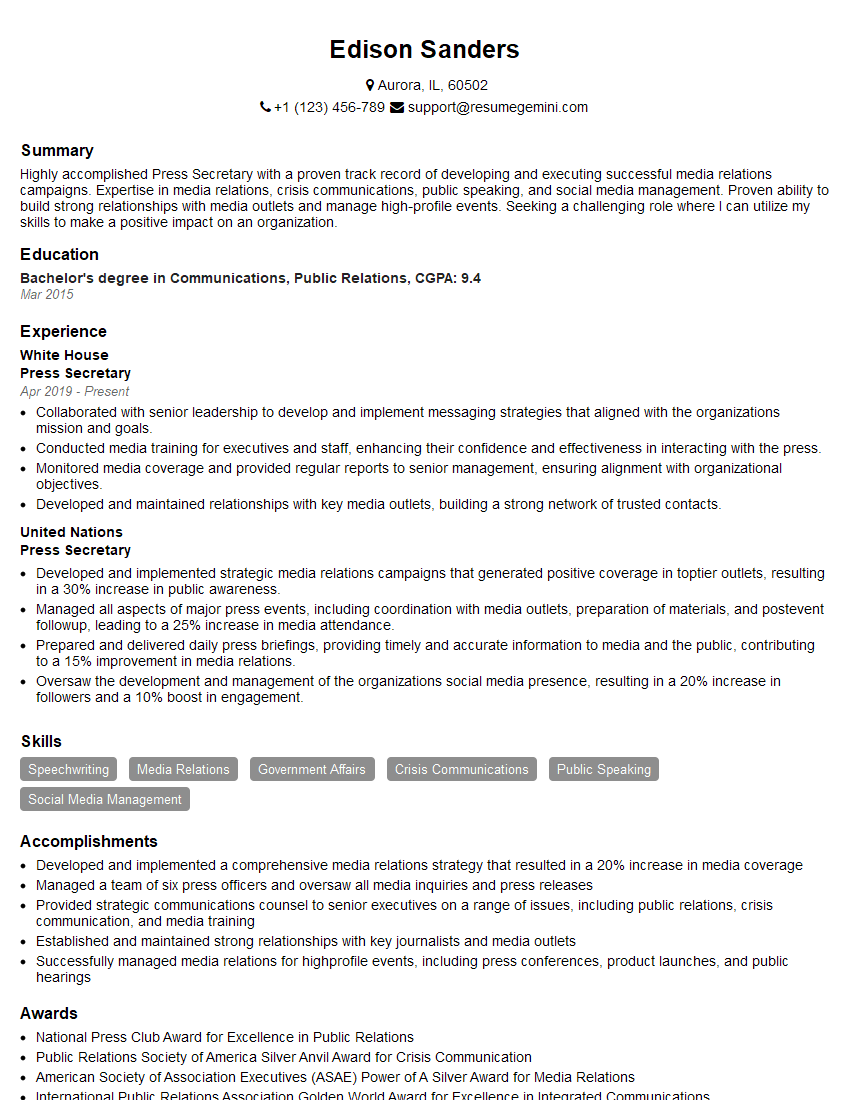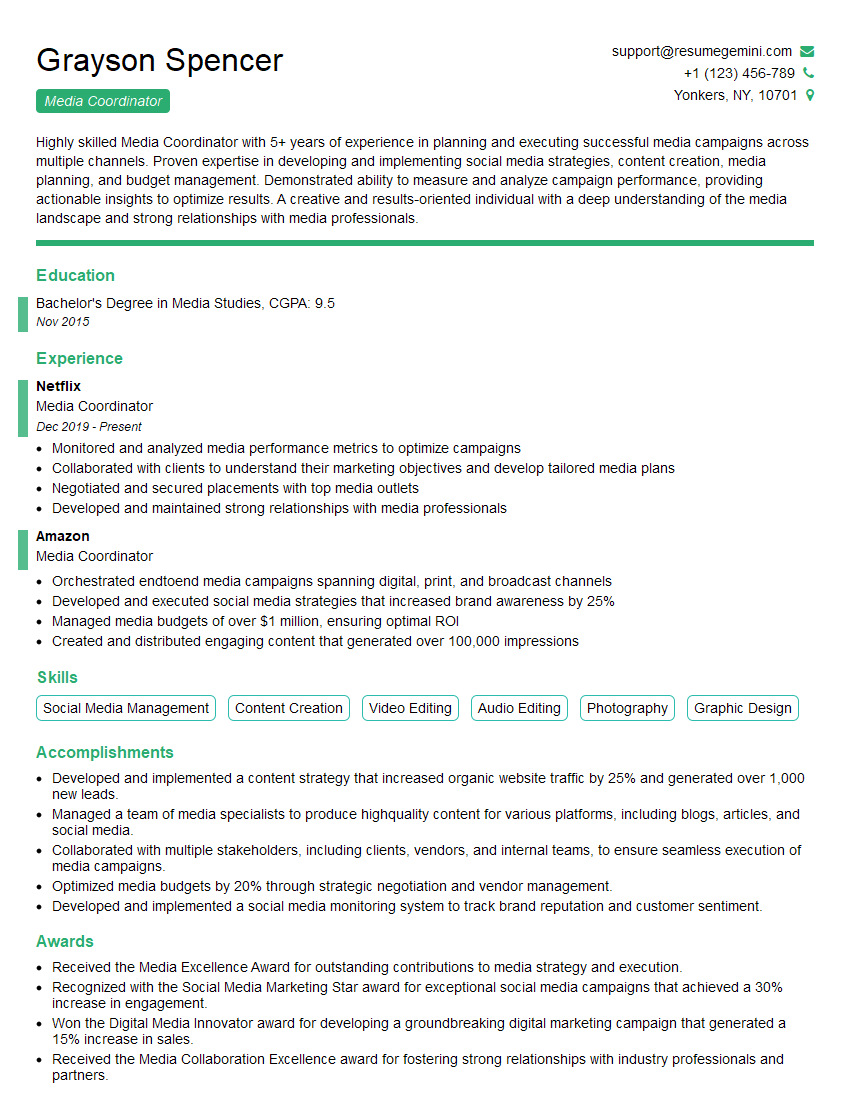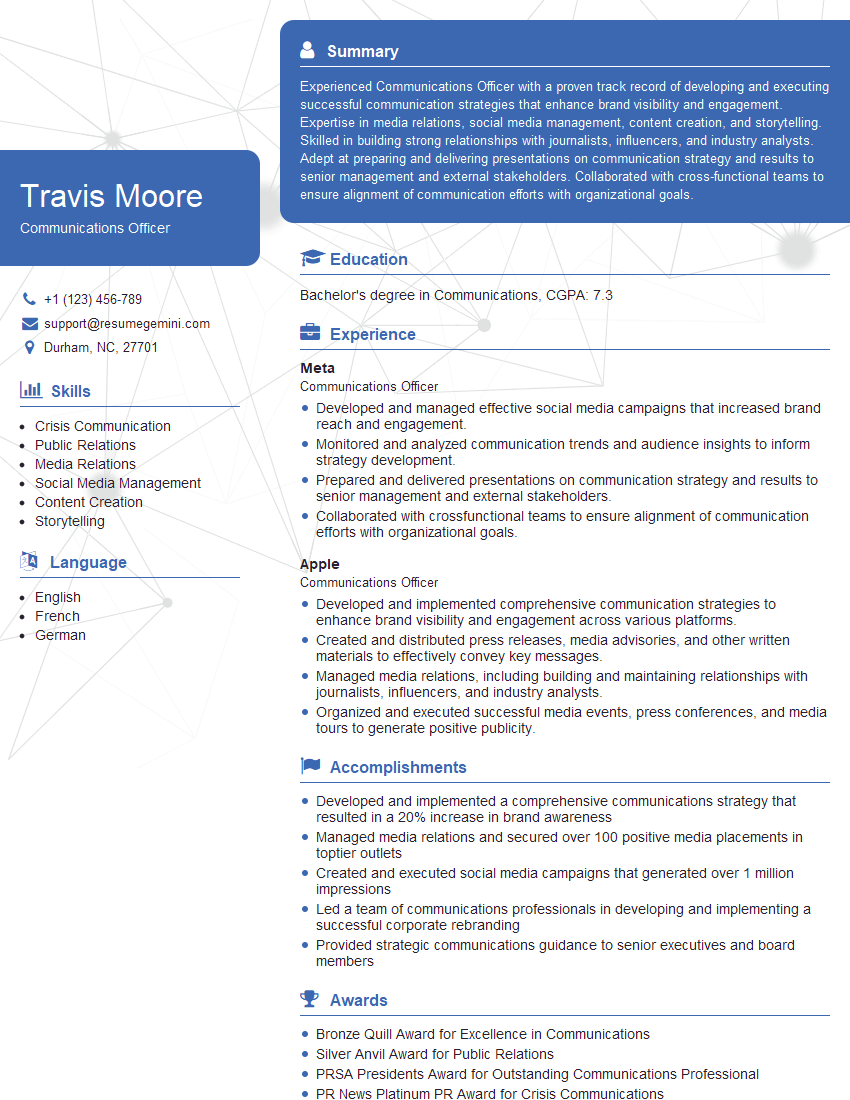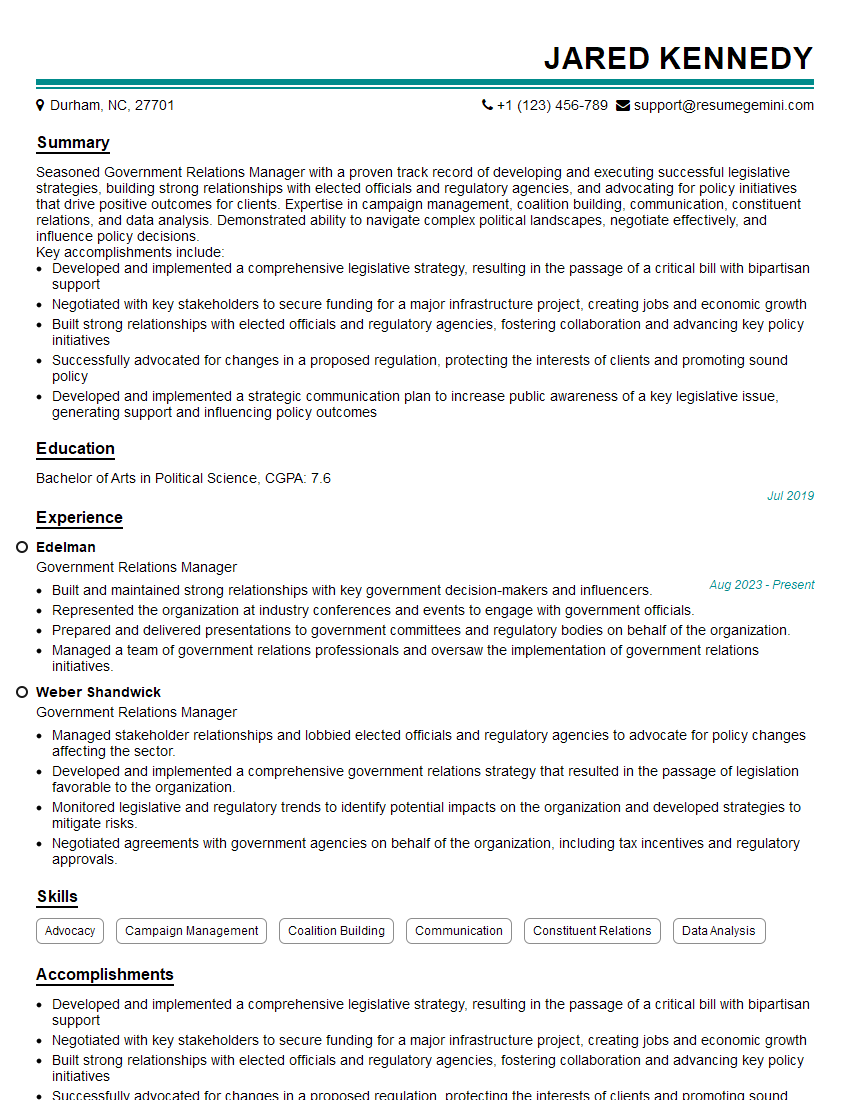The thought of an interview can be nerve-wracking, but the right preparation can make all the difference. Explore this comprehensive guide to Public Affairs and Media Operations interview questions and gain the confidence you need to showcase your abilities and secure the role.
Questions Asked in Public Affairs and Media Operations Interview
Q 1. Describe your experience managing media relations during a crisis.
Managing media relations during a crisis requires swift, decisive action and a proactive communication strategy. It’s about controlling the narrative and mitigating potential damage to reputation. My approach centers on three key phases: preparation, response, and recovery.
Preparation involves developing a comprehensive crisis communication plan, identifying key stakeholders and messaging points, and establishing clear communication channels. This includes designating spokespeople, crafting pre-approved statements addressing potential scenarios, and rehearsing responses to anticipated questions. For instance, during my time at [Previous Company Name], we developed a detailed plan addressing potential product recalls, anticipating various scenarios and pre-writing press releases.
Response is about immediate action. The first 24-48 hours are critical. This involves accurately assessing the situation, swiftly communicating with relevant parties, including media, employees, customers, and investors, and establishing a central communication hub. During a data breach incident, I led the effort to create and distribute a concise, transparent statement to all stakeholders, ensuring consistent messaging across all platforms. We prioritized empathy, acknowledging the concerns and providing clear steps to mitigate further issues.
Recovery involves monitoring media coverage, addressing ongoing concerns, and evaluating the effectiveness of the response. It’s about regaining trust and learning from the experience to improve future crisis preparedness. We conducted post-incident reviews to refine our crisis communication plan and identify areas for improvement, integrating valuable lessons learned into future strategies.
Q 2. How do you measure the success of a public affairs campaign?
Measuring the success of a public affairs campaign is multifaceted and requires a blend of qualitative and quantitative assessment. We can’t solely rely on numbers; understanding the impact on public perception is equally important.
Quantitative measures might include: changes in public opinion (through polls and surveys); media mentions (tracking volume and sentiment); website traffic and social media engagement; changes in legislation or policy; and shifts in market share or sales.
Qualitative measures focus on the narrative and public perception: changes in media framing of the issue; shifts in public discourse; enhanced relationships with key stakeholders; and overall improvements in public trust and brand reputation. For example, success in a public health campaign might be measured not only by increased vaccination rates, but also by improved public understanding and positive sentiment towards vaccination. I usually combine both quantitative and qualitative data using dashboards that visually represent our progress and highlight key achievements. This allows for a comprehensive understanding of the campaign’s success beyond just simple metrics.
Q 3. Explain your process for developing a media strategy.
Developing a robust media strategy is an iterative process that involves several key steps:
- Defining Objectives: What do we want to achieve? Increased awareness? Influence policy? Improve public perception? A clear understanding of goals is paramount.
- Identifying Target Audiences: Who are we trying to reach? This informs the messaging and media outlets we target. Different media outlets appeal to different audiences.
- Key Messaging: What is our core message? It must be concise, memorable, and consistent across all communication channels.
- Media List Development: Which journalists and media outlets are most influential with our target audience? A well-researched media list ensures our message reaches the right people.
- Content Creation: We develop press releases, op-eds, media kits, social media content, and other materials supporting our messaging.
- Timeline and Budget: We establish realistic timelines and budget allocations to ensure efficient resource management.
- Measurement and Evaluation: How will we track progress and measure success? This includes setting specific, measurable, achievable, relevant, and time-bound (SMART) goals.
For example, while working on a campaign to promote sustainable energy, we identified environmental journalists and relevant online publications as key targets, focusing our messaging on economic benefits and environmental sustainability.
Q 4. What experience do you have with government lobbying or advocacy?
I have extensive experience in government lobbying and advocacy, spanning various sectors including [mention specific sectors, e.g., healthcare, energy, technology]. My approach is collaborative and data-driven. It starts with thorough research and understanding of the political landscape, identifying key decision-makers and influential stakeholders.
I believe in building strong, respectful relationships with legislators and their staff, based on mutual trust and understanding. Effective advocacy is about providing clear, concise, and credible information, demonstrating the impact of proposed policies, and engaging in constructive dialogue. For example, I successfully lobbied for [mention a specific achievement, e.g., changes to a specific law or regulation] by collaborating with cross-party members of parliament, demonstrating the proposed changes’ societal benefit, and securing the support of key influencers within government. This involved briefing materials, presentations, and ongoing engagement to build consensus and drive support. I also have experience working with advocacy groups to coordinate effective strategies, maximizing our collective impact.
Q 5. How do you build and maintain relationships with journalists?
Building and maintaining strong relationships with journalists is crucial for effective media relations. It’s not about pressuring them for coverage, but about providing value and building trust. This involves:
- Providing accurate and timely information: Journalists value accuracy and efficiency.
- Being a reliable source: Consistency and responsiveness build trust.
- Understanding their needs: What are their deadlines? What kind of stories are they interested in? Tailor your pitches accordingly.
- Building personal connections: Attend industry events, participate in social media conversations, and engage in informal communication.
- Respecting their independence: Don’t try to influence their editorial decisions.
- Providing exclusive information or access (occasionally): This can significantly enhance the relationship.
For instance, I regularly keep in contact with key journalists in my field, sharing relevant information and insights, even if it doesn’t directly relate to my organization. This builds rapport and ensures that they think of me when relevant stories emerge.
Q 6. Describe your experience crafting compelling press releases.
Crafting compelling press releases requires a clear understanding of journalistic principles and a focus on delivering concise, impactful information. I typically follow this structure:
- Headline: Catchy and informative, summarizing the key news.
- Dateline: City and state where the news originates.
- Lead Paragraph: The most important information, answering the who, what, when, where, why, and how.
- Supporting Paragraphs: Provide further detail and context, using quotes and statistics to strengthen the message.
- Boilerplate: A brief description of the organization.
- Contact Information: For media inquiries.
I also focus on strong verbs, clear language, and avoiding jargon. A good press release is informative, engaging, and easily scannable, ensuring it gets the attention it deserves. For example, when announcing a new initiative, I would focus the press release on the tangible impact and the positive consequences it would bring, using strong quotes from stakeholders to add credibility. I always ensure the release is optimized for search engines and includes relevant keywords.
Q 7. How do you utilize social media to enhance public affairs efforts?
Social media is a powerful tool for enhancing public affairs efforts. It allows for direct engagement with stakeholders, rapid dissemination of information, and real-time feedback. My approach involves:
- Identifying appropriate platforms: Which platforms are most relevant to our target audiences?
- Developing targeted content: Tailoring messages and visuals to each platform’s unique characteristics.
- Engaging with stakeholders: Responding to comments, addressing concerns, and fostering open dialogue.
- Monitoring social media sentiment: Tracking public opinion and identifying emerging issues.
- Leveraging social listening tools: Understanding public conversations related to our organization and industry.
- Integrating social media into broader communication strategies: Using social media to support and amplify other public affairs initiatives.
For instance, during a recent campaign, we used Twitter to engage directly with legislators, sharing key information and updates, while using Facebook to connect with the wider public and share stories highlighting the campaign’s impact. We tracked engagement metrics to gauge success and refine our social media strategy, continuously adapting to public feedback. We also actively monitored relevant hashtags and keywords to promptly address any misconceptions or misinformation.
Q 8. What strategies do you employ to monitor public opinion and sentiment?
Monitoring public opinion and sentiment is crucial for effective public affairs and media operations. My approach is multifaceted and leverages both quantitative and qualitative data sources. Quantitatively, I utilize social media listening tools to track mentions of key terms and topics related to our organization or client. These tools provide valuable data on sentiment analysis – identifying the overall tone (positive, negative, or neutral) – and volume of conversations. We then analyze this data to understand trends, emerging issues, and public perception.
Qualitatively, we conduct regular surveys, focus groups, and in-depth interviews to gain a deeper understanding of public attitudes. This allows us to gather nuanced insights that may be missed by purely quantitative methods. For example, during a recent campaign for a new public transportation initiative, we used social media listening to identify concerns about accessibility. Follow-up focus groups then allowed us to understand the specific needs of various demographic groups and tailor our messaging accordingly.
Finally, we regularly review traditional media coverage (newspapers, television, radio) to identify key narratives and emerging concerns. This ensures we’re not just reacting to social media trends but also understand the broader public discourse.
Q 9. Explain your approach to managing conflicting stakeholder interests.
Managing conflicting stakeholder interests requires a strategic and diplomatic approach. My strategy begins with open and honest communication. I believe in proactively engaging all stakeholders, understanding their concerns, and ensuring they feel heard. I facilitate collaborative workshops and meetings to bring stakeholders together and foster dialogue.
Then, I focus on identifying common ground and shared objectives. Often, seemingly conflicting interests share underlying goals. Finding these common threads allows for the development of mutually beneficial solutions. For example, in a project involving land development, we had conflicting interests between environmental groups concerned about habitat loss and local businesses anticipating economic growth. Through collaborative workshops, we found common ground in sustainable development practices – allowing for economic growth while mitigating environmental impact.
Finally, transparency and compromise are crucial. Stakeholders need to understand the decision-making process and rationale. While it’s impossible to completely satisfy everyone, transparency builds trust and helps manage expectations. When compromise is necessary, I ensure it’s fair and equitable to all parties involved.
Q 10. How do you handle negative media coverage?
Negative media coverage is inevitable, but how we respond is critical. My approach is based on a proactive, three-pronged strategy: assess, address, and adapt. First, we assess the severity and scope of the coverage. We identify the source, the message, and the potential impact on public perception. This assessment helps us prioritize our response.
Next, we address the issue directly. If the coverage contains inaccuracies, we issue a factual correction or clarification. If the criticism is valid, we acknowledge the issue, explain the steps we’re taking to rectify the situation, and express our commitment to improving. We never ignore criticism; ignoring it often amplifies the negative impact.
Finally, we adapt our communications strategy. Negative coverage can highlight vulnerabilities in our messaging or operational processes. We use the experience as an opportunity to refine our strategy and improve our future communication efforts. For example, a critical report highlighting lack of diversity in our organization’s leadership prompted us to implement new diversity and inclusion initiatives and communicate those efforts transparently. This ultimately improved public perception.
Q 11. What experience do you have with media training?
I have extensive experience in media training, having developed and delivered workshops for executives, spokespeople, and other key personnel. My training emphasizes clear, concise, and consistent messaging. It also focuses on building confidence in handling challenging questions from journalists. The training incorporates practical exercises, such as mock interviews and Q&A sessions, to simulate real-world scenarios and build participants’ skills.
My approach focuses not just on what to say, but also how to say it – emphasizing body language, tone of voice, and nonverbal communication. We also cover crisis communication protocols, ensuring individuals are prepared to handle difficult situations effectively and confidently. For example, I recently trained a team of executives on how to handle sensitive inquiries related to a product recall. This prepared them to respond consistently and effectively, minimizing the negative impact of the recall.
Q 12. Describe your experience working with diverse media outlets.
Throughout my career, I’ve collaborated with a diverse range of media outlets, including national and international news organizations, local newspapers and television stations, trade publications, and online news platforms. This experience has given me a strong understanding of different editorial styles, journalistic ethics, and media landscapes. My ability to tailor messaging to resonate with specific audiences is a direct result of this experience.
I understand that each media outlet has its own target audience and preferred communication style. I tailor my approach to suit the specific outlet and its readers or viewers. For example, when dealing with a highly technical subject for a specialized trade publication, I would use different language and provide more detailed information than when addressing a general-audience news channel. This targeted approach ensures our message is effective and well-received.
Q 13. How do you ensure compliance with media regulations?
Compliance with media regulations is paramount. My approach to ensuring compliance involves staying up-to-date on all relevant laws and regulations. This includes understanding libel laws, privacy regulations (such as GDPR), and broadcast standards. I utilize legal counsel and regulatory resources to stay informed of any changes or updates. We develop internal guidelines and protocols based on the most current regulations, ensuring everyone on the team understands and adheres to them.
We implement thorough review processes for all press releases, public statements, and other communication materials to ensure compliance before release. This includes fact-checking, ensuring accurate representation, and confirming adherence to all relevant laws and guidelines. For example, before issuing a press release announcing financial results, we ensure compliance with securities regulations. This rigorous process ensures that our communications are not only effective but also legally sound.
Q 14. Explain your understanding of public policy and its influence on communications.
Public policy and communications are inextricably linked. Public policy shapes the environment in which communications operate, influencing the messages we can convey, the audiences we reach, and the regulatory framework governing our activities. Understanding public policy is essential for developing effective communication strategies.
For example, a new environmental regulation might necessitate a shift in our communication strategy, focusing on educating the public on the new rules and their implications. Conversely, effective communication campaigns can play a vital role in shaping public opinion and influencing policy decisions. Understanding policy allows us to anticipate potential challenges, identify opportunities, and craft messages that resonate with policymakers and the public alike.
I regularly monitor policy changes that are relevant to our organization or clients. This ensures that our communications strategies are aligned with evolving legal and regulatory landscapes, and we’re prepared to adapt our messaging as necessary. This proactive approach to monitoring policy ensures that our communications are effective, compliant, and contribute to positive outcomes.
Q 15. How do you develop a communications plan for a specific policy objective?
Developing a communications plan for a specific policy objective requires a strategic approach that blends understanding the policy landscape, identifying key audiences, and crafting compelling narratives. It’s like building a bridge – you need a solid foundation (research), strong supports (messaging), and a clear pathway (timeline) to reach your destination (policy success).
The process typically involves these steps:
- Situation Analysis: Thoroughly research the policy landscape, including existing public opinion, potential opposition, and relevant legislation. Analyze the strengths and weaknesses of the proposed policy.
- Audience Segmentation: Identify key audiences who will be impacted by or can influence the policy, including legislators, community groups, media, and the general public. Tailor messaging to resonate with each segment’s values and concerns.
- Messaging Development: Craft clear, concise, and persuasive messaging that highlights the benefits of the policy and addresses potential concerns. This might include key talking points, slogans, and visuals.
- Channel Selection: Choose appropriate communication channels to reach target audiences, such as press releases, social media campaigns, town hall meetings, op-eds, and direct outreach.
- Implementation and Monitoring: Execute the communication plan, closely monitoring its effectiveness and making adjustments as needed. Track media coverage, social media engagement, and feedback from stakeholders.
- Evaluation: Assess the overall success of the communications plan against its objectives. What worked well? What could be improved?
For example, when advocating for a new environmental protection law, I might target environmental groups with scientific data, while engaging the general public through emotionally resonant stories highlighting the benefits for communities.
Career Expert Tips:
- Ace those interviews! Prepare effectively by reviewing the Top 50 Most Common Interview Questions on ResumeGemini.
- Navigate your job search with confidence! Explore a wide range of Career Tips on ResumeGemini. Learn about common challenges and recommendations to overcome them.
- Craft the perfect resume! Master the Art of Resume Writing with ResumeGemini’s guide. Showcase your unique qualifications and achievements effectively.
- Don’t miss out on holiday savings! Build your dream resume with ResumeGemini’s ATS optimized templates.
Q 16. Describe your experience creating and managing a communications budget.
Managing a communications budget requires meticulous planning and resource allocation. I approach this like managing a household budget – prioritizing essential expenses and tracking every penny. My experience includes developing budgets ranging from $50,000 to $500,000, encompassing various activities.
I typically allocate resources across these key areas:
- Personnel: Salaries and benefits for communications staff.
- Media Relations: Costs associated with press releases, media kits, and media outreach.
- Advertising & PR: Expenses for print, digital, and broadcast advertising, and public relations agency fees.
- Events & Meetings: Costs for organizing and hosting events, conferences, and stakeholder meetings.
- Research & Evaluation: Funding for polling, surveys, and evaluation of communication effectiveness.
- Technology & Software: Subscription fees for social media management tools, media monitoring software, and other technologies.
I utilize project management software to track expenses, ensure accountability, and provide regular budget updates to stakeholders. Contingency planning is crucial for unexpected events or opportunities.
Q 17. How do you measure the return on investment (ROI) of communications activities?
Measuring the ROI of communications activities isn’t always straightforward, but it’s vital for demonstrating the value of communications efforts. Think of it like tracking the sales of a product – you need to connect your marketing investment to the outcomes.
My approach incorporates both quantitative and qualitative measures:
- Quantitative Measures: These involve numerical data, such as website traffic, social media engagement (likes, shares, comments), media mentions, changes in public opinion (through polling), and sales/donations linked to a specific campaign.
- Qualitative Measures: These focus on the intangible aspects, including media tone, public perception shifts (analyzed through social listening and media reports), improved stakeholder relationships, and the overall impact on policy outcomes. This often involves focus groups or surveys.
For instance, if a campaign resulted in a 15% increase in positive media coverage, and that’s linked to an increase in donations, that’s quantifiable. However, it also needs qualitative analysis to understand the quality of coverage and its overall impact. This holistic approach is essential to showcase the full picture of impact.
Q 18. What experience do you have with internal communications within a public affairs context?
Internal communications within a public affairs context are critical for maintaining alignment and engagement among team members, and keeping them informed on sensitive matters. I often use the analogy of a well-oiled machine – every part needs to work together smoothly for success.
My experience includes:
- Developing internal communication strategies: Creating plans to disseminate information effectively to employees at all levels.
- Utilizing various channels: Employing internal newsletters, intranet updates, team meetings, and informal communication channels (to cater to different preferences).
- Managing internal crises: Developing and executing communication plans to address internal issues or concerns that could impact the organization’s reputation.
- Promoting transparency: Ensuring that employees are kept informed about key policy decisions and their potential impact.
- Enhancing employee morale and advocacy: Equipping employees with the knowledge and tools to act as effective advocates for their organization’s policies.
In one instance, I successfully managed an internal communications campaign to inform employees about a significant policy change, addressing concerns through internal Q&A sessions and proactive messaging.
Q 19. How do you adapt communications strategies for different target audiences?
Adapting communications strategies for different target audiences is key to achieving desired outcomes. It’s about speaking the right language to each individual. Think of it like tailoring a suit – different styles and fabrics are needed depending on individual preferences and body types.
My approach involves:
- Audience Research: Conducting thorough research to understand the demographics, values, and communication preferences of each audience. This might involve surveys, focus groups, and analysis of social media data.
- Message Tailoring: Crafting messages that are relevant and resonate with each audience’s unique needs and interests. This includes using appropriate language, tone, and style.
- Channel Selection: Choosing the most effective communication channels for each audience. For example, older audiences might prefer traditional media (print, radio), while younger audiences might engage more with social media and digital content.
- Feedback Integration: Gathering feedback from each audience to refine messaging and approach.
For example, when advocating for a new transportation policy, I’d use different language and channels when communicating to urban residents versus rural communities. The urban audience might be concerned about public transit, while the rural population may prioritize highway infrastructure.
Q 20. How proficient are you in using social listening tools?
I am highly proficient in using social listening tools to understand public opinion, identify emerging trends, and track the impact of communication campaigns. These tools are like advanced radar systems, allowing us to see what people are saying and feeling.
My experience includes using tools such as:
- Brandwatch: For monitoring social media conversations and identifying key influencers.
- Talkwalker: For analyzing sentiment and identifying potential crises.
- Hootsuite Insights: For tracking campaign performance and audience engagement.
I leverage these tools to gather real-time insights, inform strategic decision-making, and refine communications strategies. I can analyze data to understand public sentiment toward a particular policy, identify key talking points, and measure the effectiveness of our messaging.
Q 21. What is your experience with content creation and distribution for public affairs?
My experience with content creation and distribution for public affairs is extensive. This process is about storytelling – transforming complex policy details into engaging content to inform and persuade.
My experience includes:
- Writing and editing press releases, op-eds, blog posts, and other content: I craft compelling narratives that communicate complex policy information in a clear, concise, and engaging way.
- Developing multimedia content: I create infographics, videos, and presentations to make policy information more accessible and engaging.
- Distributing content through various channels: I leverage traditional media outlets, social media platforms, email marketing, and other channels to reach target audiences.
- Optimizing content for search engines (SEO): I employ SEO best practices to ensure that our content is easily discoverable online.
- Measuring content performance: I track key metrics, such as website traffic, social media engagement, and media coverage, to assess the effectiveness of our content.
For example, I created an infographic explaining a complex tax reform bill and shared it across social media platforms, resulting in a significant increase in public understanding of the bill. I also distributed a series of policy briefs to influential journalists and policymakers, significantly increasing media coverage of our issue.
Q 22. How familiar are you with relevant legal frameworks and regulations?
My familiarity with legal frameworks and regulations governing public affairs and media operations is extensive. I possess a deep understanding of laws related to freedom of speech, defamation, privacy, data protection (like GDPR and CCPA), campaign finance, lobbying disclosure, and copyright. This knowledge informs all my work, ensuring ethical and compliant practices. For example, I’ve personally guided organizations through the complexities of navigating disclosure requirements for political advertising, preventing potential legal pitfalls. I regularly stay updated on changes in legislation through professional development and legal journals, ensuring my advice is always current and accurate.
Q 23. Describe your experience with stakeholder engagement and relationship building.
Stakeholder engagement is central to my approach. I build relationships through proactive communication, active listening, and a collaborative spirit. My experience includes working with diverse stakeholders such as government officials, community leaders, media representatives, and the public. For instance, during a recent community outreach campaign, I facilitated several town halls, addressing concerns and building consensus around a controversial infrastructure project. Building trust is paramount; this involves understanding individual needs and concerns, demonstrating transparency, and consistently delivering on promises. The result was a project successfully launched with community buy-in. I use diverse methods such as surveys, focus groups, and one-on-one meetings to ensure diverse perspectives are captured and addressed.
Q 24. How would you handle a situation where information needs to be controlled during a sensitive issue?
Controlling information during a sensitive issue requires a multifaceted approach that prioritizes transparency and accuracy. First, a rapid assessment is crucial to understand the nature of the issue and its potential impact. A crisis communication plan should be activated immediately. This involves identifying key stakeholders and developing consistent messaging. Transparency is crucial; withholding information can fuel speculation and distrust. However, releasing information needs careful consideration, adhering to legal obligations (like those related to privacy). For example, in a product recall scenario, we communicated promptly and honestly, acknowledging the problem while providing clear steps for resolution. We also established dedicated communication channels to address queries directly and promptly. Effective communication during such times minimizes damage and builds public trust. This approach involves a structured process, including media briefings, internal communications, and monitoring social media for misinformation.
Q 25. What is your understanding of the difference between earned, owned, and paid media?
Earned, owned, and paid media represent distinct approaches to communication. Earned media is unpaid publicity achieved through media coverage, positive reviews, or word-of-mouth. Think of a positive news story about your organization. Owned media is content you control, like your website, social media, or blog. It provides direct communication with your audience. Paid media involves purchasing advertising space or time, such as social media ads or television commercials. A successful communication strategy often employs a mix of all three. For example, we might use paid social media ads to drive traffic to our owned website, which contains information that is then reported on as earned media in relevant publications.
Q 26. Explain your experience using data analytics in media and public affairs.
Data analytics are integral to my work. I use data to inform strategy, measure impact, and optimize communication efforts. In a recent campaign, we tracked website traffic, social media engagement, and media coverage to identify what resonated most with the target audience and adjust our messaging accordingly. Tools like Google Analytics, social media analytics dashboards, and media monitoring software are essential for this process. This data-driven approach allows for continuous improvement, ensuring resources are allocated effectively and campaigns achieve maximum impact. This involves analyzing key performance indicators (KPIs) and using the insights to refine future strategies. For example, analyzing sentiment analysis from social media can provide early warnings of issues and allow for preemptive measures.
Q 27. How have you utilized storytelling to build public support for an initiative?
Storytelling is a powerful tool for building public support. I’ve used compelling narratives to connect with audiences on an emotional level, making complex issues relatable and memorable. During a campaign to raise awareness for environmental protection, we shared personal stories of individuals impacted by pollution, highlighting the human cost of environmental damage. This emotional approach resonated deeply with the public, fostering empathy and encouraging engagement. Effective storytelling often involves focusing on a core message, using relatable characters, and creating a clear narrative arc. Data and statistics can support the narrative but should always be presented within a compelling and human story.
Q 28. Describe your experience working with diverse teams on complex communications projects.
I have extensive experience collaborating with diverse teams on complex communication projects. Successful teamwork relies on clear communication, defined roles, and mutual respect. I value the diverse perspectives and skills that different team members bring. My approach focuses on inclusive brainstorming sessions and transparent communication practices. For instance, in developing a national public health campaign, our team included experts in public health, graphic design, media relations, and community outreach. Effective project management techniques, clear timelines, and regular progress meetings were key to ensuring a collaborative and successful outcome. Building strong team relationships often involves celebrating successes and providing constructive feedback in a supportive environment.
Key Topics to Learn for Public Affairs and Media Operations Interview
- Strategic Communication: Understanding the principles of crafting compelling narratives for diverse audiences, tailoring messaging for different media channels, and measuring communication effectiveness.
- Media Relations: Building and maintaining positive relationships with journalists, proactively pitching stories, handling media inquiries effectively, and managing crises through strategic communication.
- Public Opinion Research & Analysis: Utilizing data to understand public sentiment, identify key stakeholders, and inform communication strategies. This includes understanding polling methodologies and interpreting results.
- Crisis Communication Management: Developing and implementing crisis communication plans, managing reputation during challenging situations, and effectively communicating with stakeholders during times of uncertainty.
- Digital Media & Social Media Strategies: Leveraging digital platforms to engage audiences, build online communities, monitor online conversations, and manage online reputation.
- Government & Regulatory Affairs: Understanding the policy landscape, navigating regulatory processes, and building relationships with government officials to advocate for organizational interests.
- Stakeholder Engagement & Relationship Management: Identifying, engaging, and managing relationships with diverse stakeholders (community groups, NGOs, businesses, etc.) to build consensus and support for organizational goals.
- Content Creation & Editing: Producing high-quality written and visual content (press releases, speeches, website content, social media posts) for various platforms and audiences. This involves strong writing, editing, and proofreading skills.
- Event Planning & Management: Planning and executing successful public events, including press conferences, conferences, and community outreach initiatives.
- Ethical Considerations in Public Affairs & Media Operations: Understanding and adhering to journalistic ethics, media law, and best practices for transparency and accountability.
Next Steps
Mastering Public Affairs and Media Operations is crucial for a successful and rewarding career. These skills are highly sought after in today’s dynamic world, opening doors to leadership roles and impactful work in diverse sectors. To maximize your job prospects, focus on building a strong, ATS-friendly resume that showcases your abilities and achievements effectively. ResumeGemini is a trusted resource that can help you craft a professional resume that highlights your unique qualifications. We provide examples of resumes tailored to Public Affairs and Media Operations to guide you. Take the next step towards your dream career by building a compelling resume today!
Explore more articles
Users Rating of Our Blogs
Share Your Experience
We value your feedback! Please rate our content and share your thoughts (optional).
What Readers Say About Our Blog
Hello,
We found issues with your domain’s email setup that may be sending your messages to spam or blocking them completely. InboxShield Mini shows you how to fix it in minutes — no tech skills required.
Scan your domain now for details: https://inboxshield-mini.com/
— Adam @ InboxShield Mini
Reply STOP to unsubscribe
Hi, are you owner of interviewgemini.com? What if I told you I could help you find extra time in your schedule, reconnect with leads you didn’t even realize you missed, and bring in more “I want to work with you” conversations, without increasing your ad spend or hiring a full-time employee?
All with a flexible, budget-friendly service that could easily pay for itself. Sounds good?
Would it be nice to jump on a quick 10-minute call so I can show you exactly how we make this work?
Best,
Hapei
Marketing Director
Hey, I know you’re the owner of interviewgemini.com. I’ll be quick.
Fundraising for your business is tough and time-consuming. We make it easier by guaranteeing two private investor meetings each month, for six months. No demos, no pitch events – just direct introductions to active investors matched to your startup.
If youR17;re raising, this could help you build real momentum. Want me to send more info?
Hi, I represent an SEO company that specialises in getting you AI citations and higher rankings on Google. I’d like to offer you a 100% free SEO audit for your website. Would you be interested?
Hi, I represent an SEO company that specialises in getting you AI citations and higher rankings on Google. I’d like to offer you a 100% free SEO audit for your website. Would you be interested?
good


